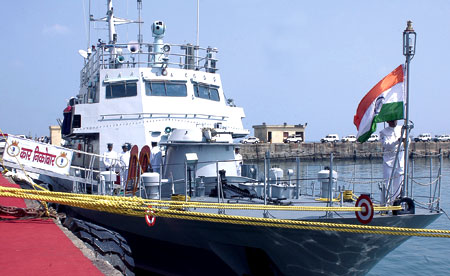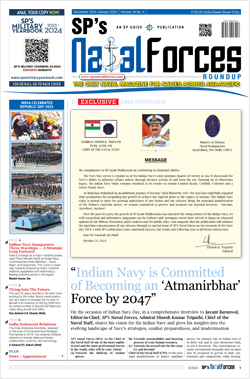INDIAN ARMED FORCES CHIEFS ON OUR RELENTLESS AND FOCUSED PUBLISHING EFFORTS

The insightful articles, inspiring narrations and analytical perspectives presented by the Editorial Team, establish an alluring connect with the reader. My compliments and best wishes to SP Guide Publications.

"Over the past 60 years, the growth of SP Guide Publications has mirrored the rising stature of Indian Navy. Its well-researched and informative magazines on Defence and Aerospace sector have served to shape an educated opinion of our military personnel, policy makers and the public alike. I wish SP's Publication team continued success, fair winds and following seas in all future endeavour!"

Since, its inception in 1964, SP Guide Publications has consistently demonstrated commitment to high-quality journalism in the aerospace and defence sectors, earning a well-deserved reputation as Asia's largest media house in this domain. I wish SP Guide Publications continued success in its pursuit of excellence.
- MoD initiates comprehensive review of Defence Acquisition Procedure 2020, pushes for defence reforms
- G7: The Swansong
- Kalinga Connect: South Asia to Polynesia
- Advanced MRSAM for India for a greater firepower
- Must Credit DRDO for Operation Sindoor, now what is next for defence R&D?
- Operation Sindoor | Day 2 DGMOs Briefing
- Operation Sindoor: Resolute yet Restrained
Operations
Brown Water Force

India has to review its concept of brown water operations for various contingencies, like normal operations, counter-insurgency/terrorist operations, police functions and disaster relief
All navies aspire to a ‘blue water’ status. But there is no set defini-tion for it. It can be described as a maritime force capable of operating across oceans. To further amplify the term, it should be a self-contained force, consisting of sub-surface, surface and airborne elements which are capable of protecting themselves while carrying out sustained operations on the high seas. The term ‘brown water navy’ was reborn during the Vietnam War in 1965, when the requirement arose for craft suitable for coastal and riverine operations.
The US Navy is credited for the origin of the term brown water navy while referring to the small gunboats and patrol boats used in rivers. Former US Navy Chief of Naval Operations Admiral Michael Mullen said in an interview, “In addition to the blue water ships, which I would characterise and describe as our aircraft carriers, and other ships that sup-port that kind of capability, we’re also looking to develop capability in what I call the green water and the brown water, and the brown water is really the rivers.”
Practically speaking, the capability to operate in blue, green or brown water depends on the individual vessel’s specifica-tions. The broader implications are that a brown water navy can carry out operations in river or littoral environment and many modern littoral-combat ships are armed with powerful anti-ship missiles.
Birth & growth of a concept
American Civil War: The term ‘brown water navy’ originated during the American Civil War. It was based on a two pronged approach in which the harbours of the Confederate states were blocked and then the Union’s forces pushed along the mighty Mississippi river, effectively dividing the Confederate territory in two and blocking their main transport route. The task of blocking the harbours was given to the US Navy whereas the gunboats operated along the Mississippi river. These gun boats were built and crewed by the US Army with a naval officer in command. Later, the boats were transferred to the US Navy. Because of the Mississippi’s murky brown water, the craft that participated in these operations were called the Brown Water Navy. Apart from an odd river patrol boat, the Brown Water Navy practically disappeared after the Civil War.
Vietnam War: During the Vietnam War, the US Navy discovered they could not intercept North Vietnamese ferrying supplies and con-traband to South Vietnam on smaller boats that traveled along the coastline. The US Navy had destroyers and the most powerful aircraft carriers but no lighter and swifter craft, capable of moving closer to the coast. In the beginning, the brown water navy patrolled the inland waterways, primarily with South Vietnamese river craft of the River Assault Groups mostly inherited from the French. As the new fiberglass Patrol Boat River (PBR), using water jet propulsion, became available, it became the main interdiction vessel for the inland waterways. The more suitable South Vietnamese Navy water craft were used for coastal operations until replaced by newer patrol vessels. Early 1965, the Naval Advisory Group in Vietnam published a study titled “Naval Craft Requirements in a Counter Insurgency (COIN) Environment”.
The study concluded that COIN water opera-tions are difficult, demanding and unique, and thus need specially tailored craft for its needs. Qualitative requirements for a small COIN craft were spelled out as follows:
• Non-wooden hull with screw and rudder protection against groundings.
• Self-sufficient for 400-500 mile patrol with a speed of 20/25 knots.
• Small high-resolution radar with a range of 4 to 6 miles and reliable long-range commu-nications equipment which is compatible with the army and air force.
• Armament for limited offence.
• Quiet operation, sparse berthing, fathometer accurate from 0-50 ft and a small, powerful searchlight.
After some research, the navy found that a boat builder, Sewart Seacraft, on the Gulf of Mexico, made water taxis used for logistic support to the gulf oil rigs. The navy bought the rights to the drawings for the “swift boat”. Seacraft was also asked to prepare some modified drawings to include a gun tub, ammunition lockers, bunks and a small gal-ley. The Navy Bureau of Ships had asked for more than 50 military modifications to the commercial design, including two 0.50-caliber machine guns in a Mark 17 turret above the pilot house; an over and under 0.50-caliber machine gun/81 mm mortar combination, mounted on the rear deck; the construction of a mortar ammunition box on the stern; and the installation of bunks, a refrigerator and freezer.
The company reacted fast and delivered the first four boats within 40 days. Designated as Patrol Craft Fast (PCF)—otherwise called Swift boats—these became the main force of the US Brown Water Navy. Mark II ver-sion had a modified deck house and Mark III version was slightly larger than Mark II. A total of 171 Mark I, II and III swift boats were constructed for the US Navy, Philippine Navy, Thailand, Cambodia, Brazil and Zaire. By the late 1960s, the Swift Boat would commence operations alongside the PBRs in the inland waters, as well as maintaining operations along the coastline. In 1970, the US Navy ter-minated its brown water naval operations and handed over the boats to Vietnam. It again had to use boats for riverine operations by the marines on the river Euphrates in Iraq.





